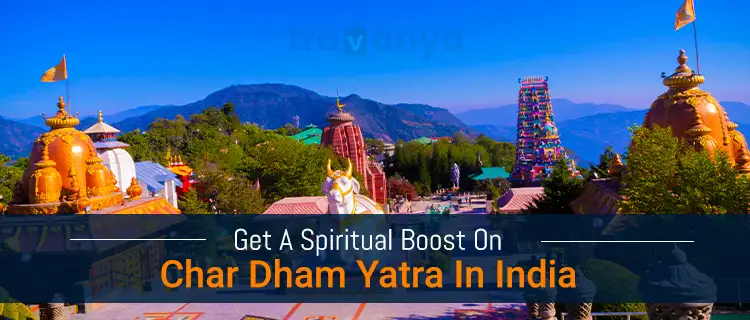
Char Dham Yatra Guide
Posted on Wednesday, January 1st, 2025 by shipra Leave a Comment
The Char Dham, also known as the four holy shrines in India, is believed to be the key to attaining moksha (salvation) and a peaceful mind. Visiting these sacred sites is considered a spiritual journey. In this guide, you’ll learn everything about the Char Dham Yatra – from its history and route map to the best time to visit these places and much more. Let’s dive in!
Types of Char Dhams In India
There are two types of Char Dhams in India –
- Bada Char Dham in India
- Chota Char Dham in Uttarakhand
For every divine and spiritual being, paying a visit to all these places is a dream come true.
Bada Char Dham Yatra
The four Char Dhams are spread across the four corners of India – North, West, East, and South. Here are the names of these sacred spots:
1. Badrinath Temple
Badrinath Temple, also known as Badrinarayana Temple, is located in Uttarakhand and is dedicated to Lord Vishnu, the preserver of the universe. It holds a special place in the 108 Divya Desams, which are temples devoted to Lord Vishnu. The temple is a pilgrimage destination for Vaishnavites all over the world and remains open for half the year, from April to November.
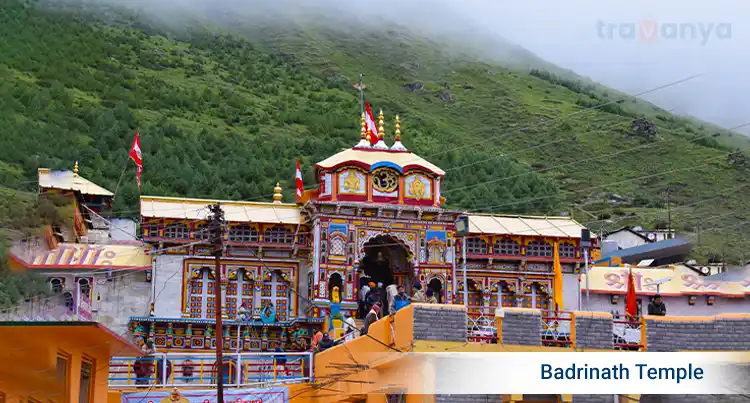
History
Previously called Badri Vishal, the temple was re-established by Adi Shri Shankaracharya to restore the lost prestige of Hinduism. It is situated in the Chamoli district of Uttarakhand. The sacred Saligram idol of Lord Vishnu was established by Adi Shankaracharya. According to the Vamana Purana, the sages Nara and Narayana, who are believed to be the fifth avatars of Vishnu, are worshipped here.
Best Time To Visit Badrinath
Summer is the best time to visit Badrinath, with the season running from May to June. During these months, the temperature stays between 8°C and 19°C, making it the perfect time for darshan. However, it’s not recommended to visit between July and September due to the high risk of avalanches.
How To Reach Badrinath Temple
Wondering how to reach Badrinath by rail, road, or air? We’ve got it all sorted in our detailed guide on how to reach Badrinath.
Route Map Of Badrinath Temple
To find your way around Badrinath and nearby destinations, refer to this route map that will guide you to the temple.
Things To Know About Badrinath Temple
- Record-Breaking Pilgrims: Badrinath Temple recorded the highest number of visitors in a year, with around 12,42,576 pilgrim visits in 2019.
- Other Deities Worshipped: In addition to Lord Vishnu, other gods like Kubera, Garuda, Badrivishal, Uddhava, Narad, Narayana, and Nar are also worshipped here.
Fairs And Festivals In Badrinath Temple
- Badrikeshwar Badri or Kedar Festival: This 8-day-long festival is celebrated in Badrinath and Kedarnath during June.
- Shri Krishna Janmashtami: The birth anniversary of Lord Krishna, considered the incarnation of Lord Vishnu, is celebrated with great excitement and joy.
2. Rameshwaram Temple
Rameshwaram Temple, located in Ramanathapuram district, Tamil Nadu, is perched on Pamban Island, separated from mainland India by the Pamban Channel. This sacred site sits on the Gulf of Mannar at the southern tip of the Indian peninsula. Transformed by the Pandya Dynasty in the 12th century, it is revered by Vaishnavites, Shaivites, and Smarthas alike.
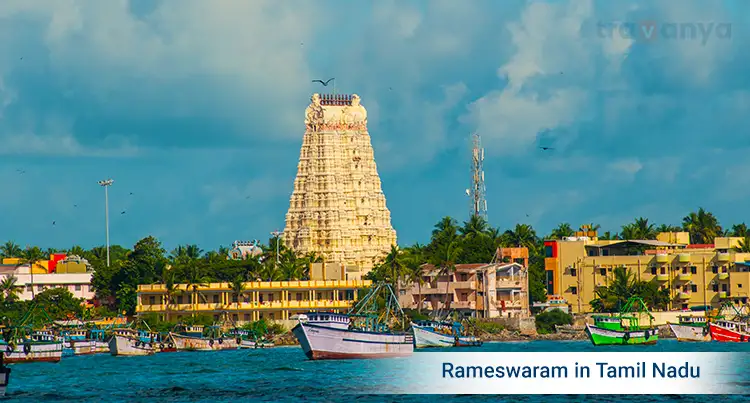
History
According to ancient Hindu texts, Lord Ram built a bridge across the sea to Sri Lanka to rescue his wife, Sita, from Ravana. The temple at the heart of the town is dedicated to Lord Shiva and holds significant spiritual value. It is considered a holy pilgrimage site by both Shaivas and Vaishnavas. Rameshwaram’s history revolves around its role as a transit point to Sri Lanka and the presence of the iconic Ramanathaswamy Temple.
Best Time To Visit Rameshwaram Temple
As Rameshwaram experiences an extreme tropical climate, the best time to visit is between October and April. During these months, the weather is generally pleasant. Winters are mild in Rameshwaram, with temperatures rarely dropping below 17°C.
How To Reach Rameswaram Temple?
- By Air: The nearest airports are Madurai Airport, located 149 km away, and Tuticorin Airport, about 142 km away. From these airports, buses, taxis, and rented cars are available to reach Rameshwaram.
- By Road: Regular bus services are operated by the local transportation authorities, connecting Rameshwaram to nearby cities. You can also opt for a road trip by car to enjoy the scenic routes.
- By Rail: The Rameshwaram Railway Station offers rail connectivity to many major cities in India, making it convenient for pilgrims and tourists.
Route Map To Rameswaram Temple
For detailed navigation and ease of travel, you can refer to a route map of Rameshwaram Temple, available online or at local travel centers.
Things To Know About Rameswaram Temple
- A Renowned Jyotirlinga: The Ramanathaswamy Temple, or Rameshwaram Temple, is one of the 12 sacred Jyotirlingas in India. This makes it a prominent site for Shiva devotees.
- Rama’s Devotion to Shiva: The temple is believed to be the place where Lord Ram worshipped Lord Shiva and sought his blessings before embarking on his journey to Sri Lanka to rescue Sita.
- Architectural Marvel: The temple is famous for its intricately designed corridors, considered the longest in the world. Walking through these corridors offers a divine and awe-inspiring experience.
Fairs And Festivals In Rameswaram Temple
Festivals such as Thiruvananathal Pooja and Palliyarai Pooja are celebrated with great enthusiasm at Rameshwaram Temple. Pilgrims can plan their visit to coincide with these festivals to witness the temple’s vibrant and cultural grandeur.
Rameshwaram Temple is not just a spiritual destination but a blend of history, architecture, and devotion. A visit to this iconic temple promises an enriching experience for every traveler.
3. Dwarka Temple
Dwarka Temple, also known as Dwarkadheesh Temple or Jagat Mandir, is a Hindu temple located in Gujarat’s Dwarka city. It is dedicated entirely to Lord Krishna, who is revered as the “King of Dwarka.”
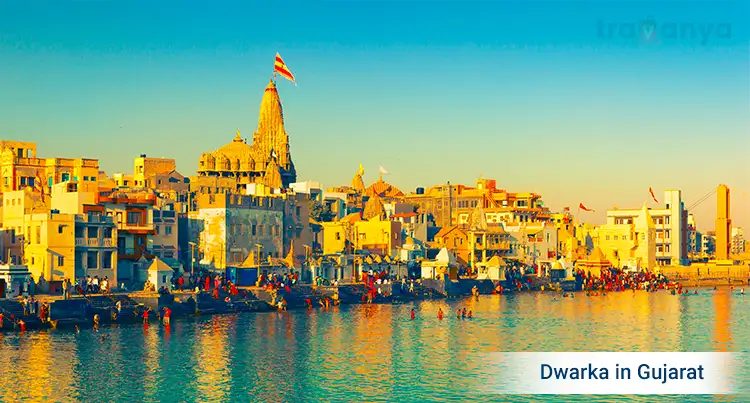
History
Built-in the Chalukyan style during the 15th-16th century, the temple is believed to stand over Hari-Griha, constructed by Vajranabha, Lord Krishna’s grandson. Additionally, the great Hindu saint Adi Shankaracharya, an eighth-century philosopher and theologian, established the Sharda Peeth at this significant location.
Best Time To Visit Dwarka
The ideal time to visit Dwarka Temple is between November and February, when the weather is pleasant, with temperatures ranging from 8°C to 23°C. However, if you wish to experience the vibrant celebration of Janmashtami, visiting in August or September is highly recommended.
How To Reach Dwarka Temple
Dwarka, located in Gujarat, enjoys excellent connectivity by road, air, and rail. You can refer to a detailed road map to navigate the city and its surrounding attractions.
- By Air: The nearest airport is Jamnagar Airport, around 137 km away. Frequent flights connect Jamnagar to cities like Mumbai and Ahmedabad, and taxis are readily available from the airport to Dwarka.
- By Rail: Dwarka Railway Station, located on the Ahmedabad-Okha rail route, connects the city to major destinations like Ahmedabad, Delhi, Mumbai, Bengaluru, and Kolkata.
- By Road: Dwarka is well-linked with cities such as Ahmedabad, Rajkot, Porbandar, Vadodara, and Amreli through frequent state-run and private bus services.
Route Map of Dwarka Temple
For ease of travel and to explore nearby attractions, follow the route map of Dwarka Temple provided here.
Things To Know About Dwarka Temple
- Approximately 5,000 Years Old: Dwarka is one of India’s ancient cities, also known as the mythical Dvaraka, established by Lord Krishna about 5,000 years ago. It is said that the kingdom featured 9 lakh palatial structures made of silver and gold, parts of which are now submerged and serve as a fascinating attraction.
- Grand Janmashtami Celebrations: Dwarka transforms into a festive paradise during Janmashtami. The city comes alive with prayers, cultural events, and buzzing local markets that remain open until midnight.
Fairs and Festivals in Dwarka Temple
Dwarka celebrates Janmashtami, Makar Sankranti, the National Kite Festival, and the Modhera Dance Festival with unmatched joy and enthusiasm. These festivals are a blend of devotion, culture, and tradition, offering a memorable experience for visitors.
4. Jagannath Temple
A vital stop in the Char Dham Yatra, the Jagannath Temple is dedicated to Lord Jagannath, a form of Lord Vishnu and one of Hinduism’s most revered deities. This iconic temple is located in Puri, Odisha, along India’s eastern coast. The current structure was built by Anantavarman Chodaganga, the first king of the Eastern Ganga dynasty. While it was reconstructed after the 10th century, the main Jagannath Temple has always stood on the same sacred ground.
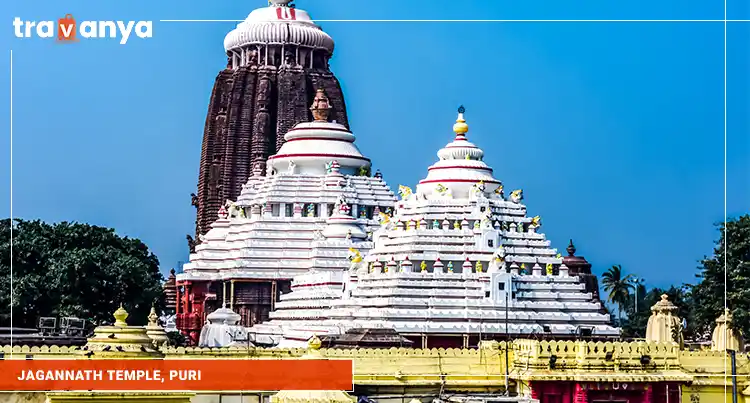
History
Constructed using Kalinga architecture during the reign of King Indradyumna, the Jagannath Temple was later rebuilt by King Anantavarman Chodaganga in the 10th century CE. Spanning a massive 400,000 square feet, the temple is surrounded by a 20-foot-high wall and features a towering pinnacle rising 192 feet above a 10-acre stone platform. The four main halls—Bhogmandapa (offering hall), Nata-Mandir (dance and music hall), Jagamohana, and Deul—showcase the grandeur of ancient architecture.
Best Time To Visit Jagannath Puri
Puri welcomes visitors year-round, except during the peak summer months (April to June). The best time to visit is from October to February when the weather is pleasant and outdoor plans are hassle-free. If you want to witness the famous Rath Yatra of Lord Jagannath, plan your trip during June or July to experience the divine blessings and vibrant celebrations.
How To Reach Jagannath Temple
- By Air: The nearest airport is Biju Patnaik Airport in Bhubaneswar, about 60 km from the temple, making it easy to reach by air.
- By Rail: Puri Railway Station, the last stop on the East Coast Railway, offers direct train connections to major cities like New Delhi, Mumbai, Kolkata, Ahmedabad, and Tirupati. Popular trains include the Howrah-Puri Express and the Jagannath Express.
- By Road: Puri’s road network is well-developed. The nearest bus stop is near the Gundicha Temple, with direct connections to Bhubaneswar, Cuttack, and nearby cities like Visakhapatnam and Kolkata.
Route Map of Jagannath Temple
Located in Puri, Odisha, the temple is renowned for its rich cultural heritage and spiritual significance. Follow the Jagannath Temple Road Map to navigate easily.
Things To Know About Jagannath Temple
- Rath Yatra: One of the temple’s most famous events, the Rath Yatra, involves parading the deities on two sets of three chariots. The deities are carried to the river separating the Jagannath Temple from the Mausi Maa Temple, crossing it on boats before reaching the Mausi Maa Temple for rituals.
- No Food Wastage: The temple ensures zero food wastage. Every morsel of the Prasad is utilized, as wasting food is considered a sin in ancient Hindu traditions.
Fairs and Festivals in Jagannath Temple
Jagannath Temple celebrates vibrant festivals like Snana Yatra, Ratha Yatra, Netrotsava, Sayan Ekadasi, and Srikrishna Janmashtami with grandeur and devotion.
Chotta Char Dham Yatra In Uttarakhand
We’ve already talked about the temples in Bada Char Dham. Now, let’s explore the iconic temples that make up the Chotta Char Dham Yatra in Uttarakhand.
1. Badrinath Temple
Since Badrinath is also a part of the Bada Char Dham, all the deets you need about this divine spot have already been shared above.
2. Gangotri Temple
Want to know about the stunning Gangotri Temple? It’s all here, so read on and soak up the vibes of this spiritual place. The temple is located in the Uttarkashi district and holds immense religious significance.
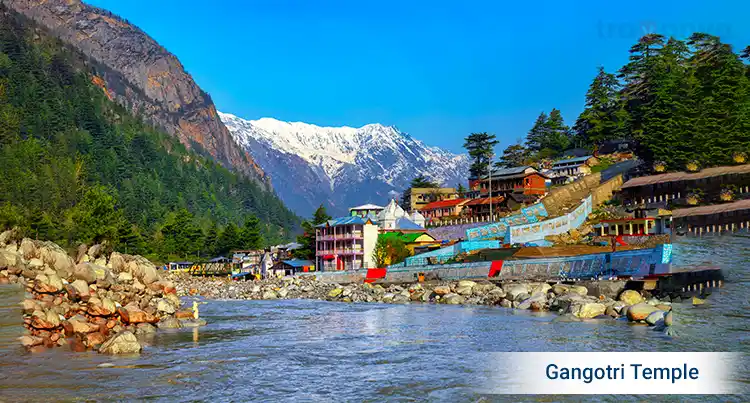
History
After an earthquake in 1803 caused the Gangotri Temple to collapse, it was rebuilt in 1807 by Gorkha Maharaja Amar Singh Thapa. This temple, crafted in the Nagara style of architecture, is made entirely of white marble. Britishers also explored this iconic place during the early 1800s. Sitting on the left bank of the Bhagirathi River, the temple has a unique tradition where water from Gangotri is offered to Lord Shiva. This water is believed to be divine nectar that soothes Shiva’s throat, as he swallowed poison to save the universe.
Best Time To Visit Gangotri Temple
Gangotri is cold almost all year round. The best time to visit is between April-June or September-October, when the weather is relatively pleasant. Want more weather insights? Check them out here.
How To Reach Gangotri Temple
Planning your Chotta Char Dham Yatra? Here’s a quick guide on reaching Gangotri Temple.
Route Map of Gangotri Temple
Check out the route map of Gangotri Temple for details on nearby locations and directions.
Things To Know About Gangotri Temple
- Open for six months only: Located over 3,000 meters above sea level, the temple is open only during the summer months due to extreme weather conditions.
- Gaurikund: Don’t miss this unique pool near the temple, formed by a waterfall. The bulging rock in the pool is known as Shivling.
Fairs And Festivals In Gangotri Temple
The Gangotri Valley celebrates Hindu festivals like Holi, Diwali, and Dussehra with full enthusiasm. Locals also host fairs and festivals dedicated to their deities.
3. Kedarnath Temple
Part of the Chotta Char Dham Yatra, Kedarnath Temple is a stunning shrine dedicated to Lord Shiva. Located in Uttarakhand’s Rudraprayag district, it stands near the Mandakini River in the Garhwal Himalayas. The temple, positioned at 3,583 meters (11,755 feet), is around 223 kilometers from Rishikesh. It is open to pilgrims only between April and November due to harsh weather.
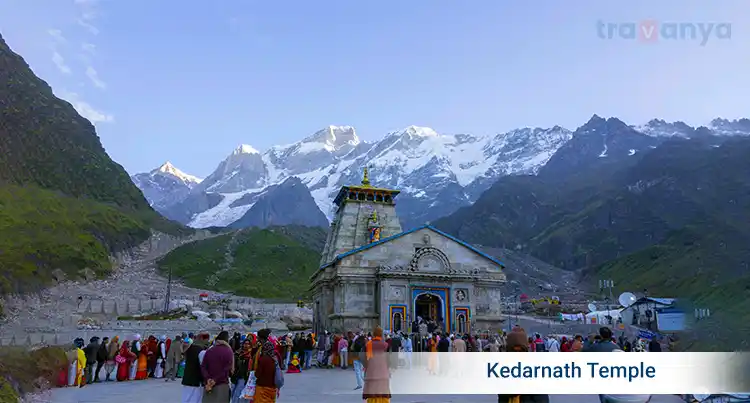
History
The name Kedarnath translates to “Lord of the Field,” derived from the Sanskrit words kedara (field) and natha (lord). According to the Kashi Kedara Mahatmya, this name symbolizes the “field of liberation.” The temple is also a significant site for the celebration of Maha Shivratri.
Best Time To Visit Kedarnath Temple
Get all the insights about the best time to visit Kedarnath Temple to make your trip worthwhile.
How To Reach Kedarnath Temple
For a detailed travel guide, check out how to reach Kedarnath Temple.
Route Map Of Kedarnath Temple
Check the route map of Kedarnath Temple to make your journey seamless.
Things to Know About Kedarnath Temple
- Bhaironath Temple: Just a short distance from Kedarnath, Bhaironath Temple is believed to protect Kedarnath by warding off evil during its closed months. Visiting Bhaironath is part of the rituals when Kedarnath reopens.
- One of the 12 Jyotirlingas: Kedarnath houses one of Lord Shiva’s 12 Jyotirlingas. Its origins trace back to ancient times when austerities were performed by Lord Vishnu’s incarnations, Nar and Narayana.
Fairs And Festivals In Kedarnath Temple
Festivals like Vinayak Chaturthi and Deepawali bring vibrancy to Kedarnath, especially in September and October.
4. Yamunotri Temple
At an altitude of 3,291 meters, Yamunotri Temple is a serene shrine dedicated to Goddess Yamuna. The temple lies amidst the Garhwal Himalayas and marks the origin of the sacred Yamuna River. Surrounded by majestic mountains and the enchanting Surya Kund (hot spring) and Gauri Kund (cold spring), it’s one of the four Chotta Char Dham sites.
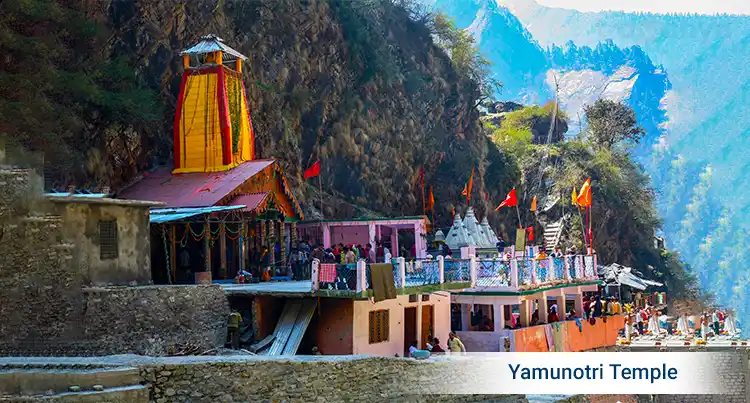
History
Constructed in 1839 by King Naresh Sudarshan Shah of Tehri, Yamunotri Temple is made of granite stones. Its yellow cone-shaped spire with red lines adds a unique charm. Legend has it that Sage Asti Muni, who bathed in the Ganga and Yamuna daily, was blessed by Goddess Ganga when he could no longer travel to Gangotri. Yamuna Devi, the temple’s deity, is considered the daughter of Saranyu Devi (Goddess of perception) and Surya Devta, as well as the sister of Lord Yama (God of death).
Best Time To Visit Yamunotri Temple
Summer is the best season to experience Yamunotri’s serene beauty. To witness its cultural essence, visit during festivals like Basant Panchami and Phool Dei. For more weather details, click here.
How To Reach Yamunotri Temple
Looking for a travel guide? Check out the directions and travel tips for reaching Yamunotri Temple.
Route Map Of Yamunotri Temple
Follow the route map of Yamunotri Temple for a smooth journey.
Things To Know About Yamunotri Temple
- Sacred River: The Yamuna River is one of the seven sacred rivers in India, making Yamunotri Temple a revered site.
- Significance of Bhai Dooj: According to the Skanda Purana, Yamuna fasted for her brother Yama on Kartik Shukla Dwitiya, a day now celebrated as Bhai Dooj.
Fairs And Festivals In Yamunotri Temple
Festivals like Vasant Panchami, Phool Dei, and Olgia add color and vibrancy to Yamunotri.
Tips To Follow While Visiting 4 Dham Yatra In India?
- Know the best time to visit: Before setting out on your Char Dham Yatra, it’s always a smart move to research the best time to visit. This ensures you make the most of your trip and create unforgettable memories. For more temple options in Uttarakhand, click here.
- Analyze flight costs: Comparing flight prices is hands-down one of the best ways to score great deals. Check and compare fares from multiple airlines to find the lowest prices. You can explore various flight options on our website, where plenty of booking choices are available.
- Save ahead of time: Booking your flights early can help you grab the lowest fares. It’s usually recommended to book at least 1-2 months in advance. Airlines often roll out special rates for flights scheduled weeks or months ahead, so don’t wait till the last minute.
- Use airline miles: If you’re a frequent flyer, make use of the miles you’ve earned from previous flights. Most airlines let you redeem these for discounted tickets, so check if you can use your miles to save big.
- Join a loyalty program: Signing up for an airline loyalty program can get you access to exclusive deals and discounts. Many airlines offer special perks to members, so make sure to join before booking your tickets.
Frequently Asked Questions
Q: Which god is worshipped in the Badrinath Temple of Uttarakhand?
A: Badrinath is known for worshipping Lord Vishnu, also referred to as Badri Vishal or Badri Narayan. He’s depicted holding a Shankh (Conch) and Chakra in two hands, while the other two hands rest in a Yogamudra posture.
Q: How much time is required for Char Dham Yatra?
A: Completing the Char Dham Yatra takes 10-12 days if done by road. If you opt for a helicopter service, the journey can be completed in just 4-5 days.
Q: Which month is better for Char Dham yatra?
A: The best months for the Char Dham Yatra are from April to June. The weather is favorable during summers, making it the ideal time to travel.
Q: Is a medical certificate required for the Chardham yatra?
A: Yes, carrying a medical certificate is mandatory. It ensures you’re fit to handle the harsh weather conditions during the journey.
Q: What are the precautions for Char Dham yatra?
A: In October and November, pack thick woolens to stay warm. During summer, lighter woolens will suffice. Also, bring a woolen blanket, raincoat, umbrella, torch, canvas shoes, and minimal luggage.
Q: What medicines are required to carry for the Chardham yatra?
A: Always carry a mosquito repellent to avoid bites and diseases like malaria. Keep a basic medical kit with essentials for fever, diarrhea, and other emergencies..
Q: How to prepare for Chardham yatra?
A: Research basics like the best time to visit, essential medicines, and safety precautions. Also, carry dry and packaged food for the journey.
Q: Is char dham yatra difficult?
A: The rocky terrain and high altitudes can cause mountain sickness. According to The Indian Express, the Kedarnath trek is one of the riskiest in India, with challenges like exhaustion, unpredictable weather, and low oxygen levels. For ease, check maps for Yamunotri, Gangotri, Kedarnath, and Badrinath.
Q: Should I carry cash or a card during the char dham yatra?
A: Carrying cash is essential for remote areas. Make sure to have enough cash, along with a credit or debit card as a backup. Don’t forget warm clothes and rain gear for your adventure in the Himalayas.
If you’re planning to visit these sacred destinations, booking a holiday package is a fantastic idea, and Travanya is here to help! With a variety of customizable packages, we’ll make sure your journey is smooth and memorable. Our travel experts will take care of everything from start to finish.
About shipra View All Posts
Explore travel insights and expert tips by Shipra on Travanya’s blog. Discover unique destinations, travel guides, and inspiration for your next adventure."



Leave a Comment